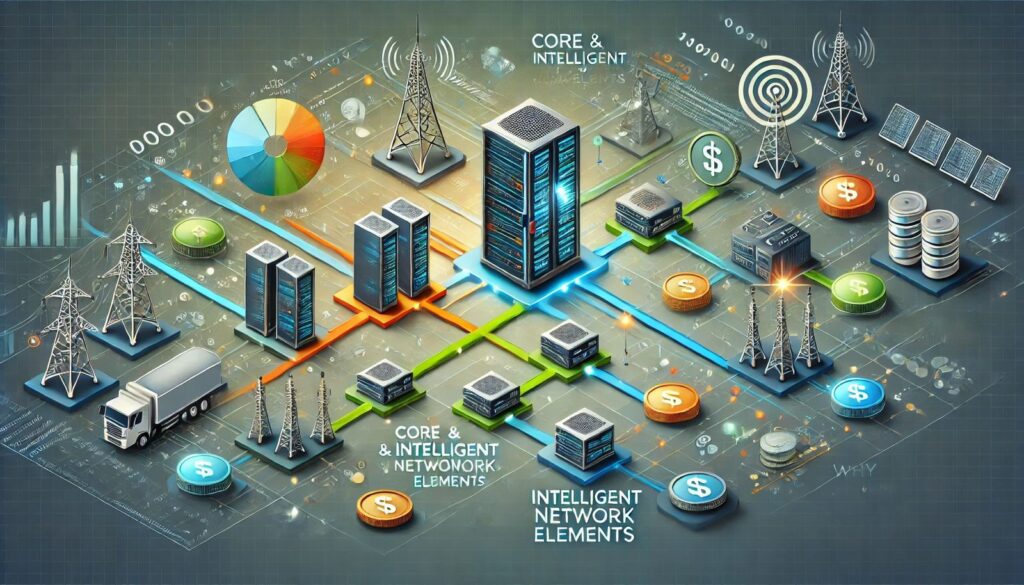Introduction
In modern telecom networks, core network elements and intelligent network (IN) elements play critical roles in managing services like voice, SMS, and data. Understanding how these elements interact is vital for ensuring accurate revenue assurance, which is a key challenge for telecom operators. This post explains the functions of key network components and highlights the importance of reconciliation for managing revenues effectively.

Core Network Elements
Mobile Switching Center (MSC):
-
- Role: The MSC is responsible for managing voice calls and SMS in both 2G and 3G networks. It handles the switching and routing of these services, ensuring smooth communication between mobile users and other network types such as the PSTN (Public Switched Telephone Network).
- Key Functions:
- Call setup and teardown.
- Mobility management, including location updates and handovers.
- Generation of Call Detail Records (CDRs) for billing purposes.
- SMS handling between mobile subscribers and external messaging systems.
Serving GPRS Support Node (SGSN):
-
- Role: The SGSN is part of the packet-switched (PS) domain in 2G and 3G networks. It is responsible for the delivery of data services, including internet access, over GPRS and UMTS. The SGSN manages the mobility of users and keeps track of their data usage.
- Key Functions:
- Session management for data services.
- Authentication and mobility management within the PS domain.
- Collecting data usage statistics for billing.
- Forwarding data sessions to the Gateway GPRS Support Node (GGSN).
Gateway GPRS Support Node (GGSN):
-
- Role: The GGSN is the gateway between the mobile network’s PS domain (managed by the SGSN) and external packet data networks, such as the internet. It assigns IP addresses to mobile users and routes data between the mobile network and the external network.
- Key Functions:
- Management of IP addresses for mobile devices.
- Billing data generation for data services.
- Acting as a liaison between mobile data networks and external packet networks.
Serving Gateway (SGW) and Packet Data Network Gateway (PGW):
-
- Role: In 4G LTE networks, the SGW and PGW replace the SGSN and GGSN, respectively, to handle data traffic. The SGW routes and forwards packets between the eNodeB (base station) and external networks. The PGW connects the LTE network to external packet data networks, such as the internet, managing IP address assignment and handling services like billing and policy enforcement.
- Key Functions:
- SGW: Forwarding data traffic within the LTE network and between the LTE network and external networks.
- PGW: Managing mobile user IP traffic, including routing, IP address assignment, and applying policies for billing.
Intelligent Network (IN) Elements
Intelligent Network (IN):
-
- Role: The IN manages value-added services like prepaid billing, call forwarding, and other real-time services. The IN interacts with the MSC and other core network elements to provide these services while keeping track of real-time user balances and other account information.
- Key Functions:
- Real-time prepaid charging.
- Execution of customized services like VPNs and number portability.
- Supplementary service control (e.g., balance inquiries, top-ups).
Why Reconciliation is Crucial for Revenue Assurance
Telecom operators must ensure that the records generated by core network elements like the MSC, SGSN, GGSN, SGW, and PGW match the real-time billing information recorded by IN systems. Any discrepancies between these systems can lead to significant revenue leakage. Here’s why reconciliation is essential:
- Accurate Billing: Core elements such as the MSC and SGSN/GGSN generate CDRs for voice, SMS, and data usage. These records must be reconciled with billing information from IN systems, especially for real-time services like prepaid charging. If a mismatch occurs, operators risk revenue loss, either by overcharging or undercharging customers.
- Revenue Assurance: Discrepancies between the traffic data captured by core network elements and the charging data in the IN can lead to missed revenue opportunities. For instance, if the IN fails to register a data session or voice call correctly, the operator may not capture the associated revenue.
- Fraud Prevention: Reconciling data from the core and IN networks also helps detect and prevent fraud, such as bypassing prepaid billing systems or unauthorized use of services. By correlating voice, SMS, and data usage records across systems, operators can identify unusual patterns indicative of fraud, like SIM box fraud or call bypass.
- Ensuring Service Quality: Reconciliation not only ensures proper billing but also enables operators to monitor and maintain the quality of services. By comparing the data from different systems, operators can ensure that services are delivered according to the promised quality and detect any service anomalies.
Conclusion
For telecom operators focused on revenue assurance, reconciling data between core network elements (MSC, SGSN, GGSN, SGW, PGW) and intelligent network elements (IN) is crucial. This process ensures accurate billing, prevents revenue loss, and helps detect fraud, all while maintaining high service quality.
Implementing robust reconciliation processes using Big Data Analytics can help operators stay ahead of potential revenue leakage and improve operational efficiency.


